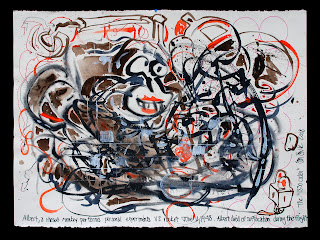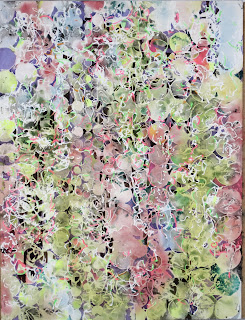
OTHER VOICES: "I kept thinking about it. Do you think courage is something everyone has, given the situation?"…….. "If you're lucky!"….. "Courage is being afraid, but acting on your convictions and inner compass anyway. I think it is. "……"I think it is."…… "I think there has to be an element of risk or loss for courage to be exhibited. Risk and loss both have an element of fear to them, so yes fear is a component of courage. I think individuals may not be aware of the risk involved in their actions at the time, but risk/loss is still there."……. "Only in the actions, maybe. It is courage either way. Don't you think?"….. "We had a pit-bull dog a long time ago and there was a mean boxer dog in the neighborhood that ran loose. When the boxer came up to our pit-bull Dolly she would whine but she would not run she instead was prepared to fight. Isn’t that courage, to be afraid but not to run?"….. "Dolly was also protecting her family which I believe is courageous. Medals are awarded for both bravery and for courage so there is a difference. I think bravery is when you do something that might hurt you, and even though you are afraid, BUT it is an EXPECTED response in those circumstances... (e.g. fighting in battle; having a tooth out; a firefighter saving someone from a burning building). But COURAGE is when you do something that might hurt you, (like Dolly knew it would hurt to fight) and even though you are afraid, BUT it is done purely to help someone else (altruism) and it is not expected of you (e.g. dashing out to drag a dying friend back; jumping into a river to save a stranger..). However I think these days, people use the terms interchangeably without really reflecting on the difference."…. "Do you always answer a question with a question? (I can't answer your question because it flew over my head again.)"…. "I'm thinking physical courage does entail the risk/loss, possibly physically or emotionally; whereas, moral courage is something more personal and may be completely unnoticed by the outside world. It can be as simple as making a decision, one that may be harder, but it's what you deem to be right. ... Maybe moral courage is more the courage of self and physical courage, the courage for others."…. "Oh, I don't know."…. "Tom, I was speaking of acting out of that courage. I wouldn't think that courage could be dormant. "….."Or, maybe dormant would not be as good a description as "inactive" I see courage tied to some activity."…. "back to action. Is the demonstration of courage a part of the overall concept? Or, can it lie fallow and still be called courage?"….. "YES!"….. "Physical and moral courage shouldn't be considered in the same category; one is very externally motivated and the other emanates from one's inner world. Physical courage says much less about one's character unless it is used in the pursuit of moral courage. Moral courage challenges the self and it usually is more lonely; not for those who need acknowledgment or Woo Hoos."…… "so much for brevity!"… "Thank you, Tom. Enjoying the whole thing. Very interesting and though-provoking. I have seen quiet courage in small actions and words. All courage is inspiring and can begin a domino effect. Like a smile."….. "I find them remarkably similar, both beginning with a prayer prior to action: "oh god oh god oh god OH!!!""….. "My brain still hurts from the last one. I think that, when the moment arrives, doubt doesn't get a chance to rear its head. A person shifts into auto pilot and just goes with it. Maybe."….. "Definitely not. Hesitation, maybe. Courage calls for immediate action. That's part of the definition."….. "Doubt is a hindrance to courage. Sometimes doubt makes you see the difference between being fool hardy and being courageous." …….................................................................................
"Fear is a response. Courage is a decision."
FOUNDATION
"That which from the point of view of the finite world appears as self-negation is from the point of view of ultimate being the most perfect self-affirmation, the most radical form of courage."
Paul Tillich The Courage to Be 1952
Images:
1. "Prempro"© 2003
Watercolor on paper
2. "Jessica Lynch #4"© 2003
Watercolor on paper
3."Investigation"© 2003
Watercolor on paper with push pins.
Paintings by Tom Schulz
Paintings by Tom Schulz
Other Voices includes Facebook responses to the following questions:
1. Is courage something you access as a response to a particular situation?
2. Is there a difference between physical courage and moral courage?
3. Where does doubt factor in? Can doubt be a catalyst for courage?
Being compliant while still asking questions. Trying to pay attention to disparate information. Allowing myself to be turned inside out. Hearing without too much judgment. Opening the blinds. Today these things will define courage (for me). What defines courage for you, Human?
Next: Courage and Change.
Next: Courage and Change.






















